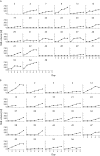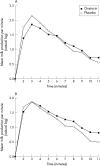Randomised, double blind trial of oxytocin nasal spray in mothers expressing breast milk for preterm infants
- PMID: 16223754
- PMCID: PMC2672698
- DOI: 10.1136/adc.2005.081265
Randomised, double blind trial of oxytocin nasal spray in mothers expressing breast milk for preterm infants
Abstract
Background: Human milk has considerable short and long term benefits for preterm infants, but mothers may experience difficulties in expressing breast milk for infants too immature or sick to breast feed. Oxytocin has been used to assist breast feeding and milk expression, but few data are available to support this intervention in the neonatal unit setting.
Aim: To test the hypothesis that oxytocin nasal spray increases early milk output in mothers expressing milk for preterm infants.
Methods: A randomised, double blind trial of oxytocin nasal spray (100 microl per dose) versus placebo was conducted in mothers delivering infants <35 weeks gestation. Sprays were used before expression of milk using an electric pump up to day 5.
Main outcome: Total weight of milk expressed while using spray (study powered to detect >1SD difference between groups).
Secondary outcomes: Pattern of milk production; number of pumping sessions; weight/fat content of milk expressed during a fixed 20 minute period on day 5 ("physiological study"); mother's opinion of expressing and spray assessed by questionnaire.
Results: Fifty one mothers were randomised (27 oxytocin, 24 placebo). Total milk production did not differ between groups. Repeated measures analysis of variance suggested significantly (p = 0.001) different patterns of milk production, with initial faster production in the oxytocin group then convergence between groups. Parity did not influence the response to the intervention. No significant differences were seen in milk weight or fat content in the physiological study nor in mothers' opinions of milk expression and treatment.
Conclusions: Despite marginal differences in the pattern of early milk production, the use of oxytocin nasal spray did not significantly improve outcome. Most mothers believed they were receiving the active spray, suggesting a significant placebo effect (supported by limited data from historical controls) and benefits from the extra breast feeding support available during the study.
Conflict of interest statement
Competing interests: none declared
References
-
- Lucas A, Cole T J. Breast milk and neonatal necrotizing enterocolitis. Lancet 19903361519–1523. - PubMed
-
- Narayanan I, Prakash K, Gujral V V. The value of human milk in the prevention of infection in the high‐risk low birth weight infant. J Pediatr 198299496–498. - PubMed
-
- Singhal A, Cole T J, Lucas A. Early nutrition and later blood pressure: two cohorts after a randomised trial. Lancet 2001357413–419. - PubMed
Publication types
MeSH terms
Substances
LinkOut - more resources
Full Text Sources
Medical



